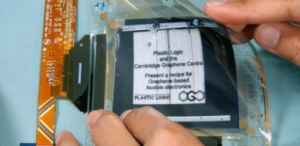Graphene is a sheet of carbon atoms arranged in a chicken wire pattern. It is a 2D material, which at only one-atom thick manages to be 200 times stronger than steel and able to move electrons across its surface up to three orders of magnitude better than silicon.

Graphene at a glance
It is also the best conductor of electricity and heat known to man, with intriguing optical properties. Graphene is very lightweight, flexible and has a large surface area. It comes at a relatively high price at the moment, but depending on improvements to current production methods, it should be quite cheap as it is only made of naturally abundant carbon atoms.

Thanks to graphene’s host of amazing attributes, scientists and industry experts refer to it as a ‘miracle material’ and are excited about its potential to revolutionize entire markets. Graphene is vigorously studied and may well enable advances like bendable and transparent computer screens, cheaply desalinated water using graphene membranes, low-cost and efficient solar panels, lightning fast microcomputers, light and powerful batteries that charge within minutes, unique sensors, and much more*. Graphene’s full spectrum of possibilities seems to be a long way from being discovered.
Graphene for displays
Given graphene’s conductivity, flexibility and transparency, displays are a natural choice of path for graphene use. The three most popular areas are graphene-based conductive wires for transparent touch panels, display backplanes and transparent electrodes for OLEDs. Graphene can also be used to produce OLED encapsulation, quantum dots and laser diodes.
Prototype E Ink display with graphene electrodes, by FlexEnable
Touch panels
One of the first applications suggested for graphene was transparent conductive wires for touch screens. Graphene is a great conductor, as well strong and flexible, which makes it a very good choice to replace the fragile and expensive ITO currently in use.
Most analysts agree that touch panels no longer represent a major opportunity for graphene. Several other technologies, such as silver mesh, silver nanowires and even carbon nanotubes, seem to be more advanced and seem to be better suited than graphene for this specific application. The main advantage of graphene-based transparent films is in their optical performance.
Transparent display electrodes
All displays use transparent electrodes, and graphene, with its high conductivity and transparency is an exciting material for this application.
Towards the end of 2015, researchers at Korea’s ETRI Institute developed transparent graphene-based electrodes for OLED panels. The researchers say that these new electrodes improve the transparency and “image quality” of OLEDs by 40 to 60 percent, compared to current silver-based electrodes. ETRI says that this technology will be especially suitable for transparent OLEDs and panels based on white OLEDs. Interestingly, a few weeks later the OLED Association, a trade group that promotes OLED technologies, published an interesting article in which they say Samsung is aiming to use graphene-based transparent electrodes in future OLED TVs. Perhaps this forecast is based on the ETRI research.
Display backplanes
Another possible application for graphene is display backplanes – the electronics that drive the display. Organic TFTs are being intensively researched by many companies as the need for cheap, low-temperature processed and flexible electronics is high – mainly for flexible OLED displays.
Graphene, in its natural state, does not have a bandgap – so it cannot easily be used as a backplane material – it is first required to introduce a bandgap into graphene (for example by using nanoribbons). Another, perhaps more promising approach is to use a different 2D material that has an intrinsic bandgap such as MoS2.
Quantum Dots
Graphene has the potential to be an excellent QD material, useful to enhance LCD displays and provide an emitting material for next-gen QD-LEDs.
Thermal and EMI foils
LED-based LCD TVs heat up, and makers use thermal foils to dissipate the heat. Graphene is the world’s best thermal conductor and so graphene-based foils are very attractive. Graphene can also be used for EMI shielding, which is also used in many displays.
Several companies are already offering thermal and EMI foils. In March 2015, Ohio-based Angstron Materials announced cost-effective thermal foil products that can be customized for handheld devices and other products. Angstron’s thermal foils are available in a variety of grades, and the company states that its graphene foils are thinner than other products on the market and so give manufacturers greater design flexibility than competing methods. Angstron says it is able to tailor its thermal foil sheets in thicknesses ranging from 5 um to 40 um with thermal conductivity between 800 W/m-K and 1,700 W/m-K. These foils can also be used for EMI shielding – Ron Mertens
* I think it was The Economist that said that graphene’s properties include an amazing ability to separate VCs from their cash! (BR)
Ron Mertens is Graphene-Info’s editor-in-chief. Graphene-Info has been the leading international graphene publication for over five years, with a readership of tens of thousands of professionals a month. It provides a multitude of services to the graphene market based on extensive and up-to-date knowledge hub and close ties with industry leaders. Graphene-Info recently published a market report dedicated to graphene’s role and potential applications in the display and lighting markets.

